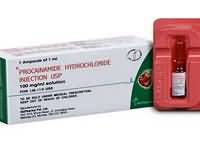CLINICAL USE
Anti-arrhythmic agent:Treatment of ventricular arrhythmias, especially after myocardial infarctionAtrial tachycardia
DOSE IN NORMAL RENAL FUNCTION
Slow IV injection: 50 mg/min (100 mg with ECG monitoring), repeated at 5-minute intervals until arrhythmia is controlled; max dose 1 gInfusion: 500–600 mg over 25–30 minutes with ECG monitoring, then maintenance of 2–6 mg/minute. If required start oral anti-arrhythmics 3–4 hours after infusion
PHARMACOKINETICS
DOSE IN RENAL IMPAIRMENT
GFR (mL/MIN)
DOSE IN PATIENTS UNDERGOING RENAL REPLACEMENT THERAPIES
IMPORTANT DRUG INTERACTIONS
Potentially hazardous interactions with other drugs
ADMINISTRATION
Reconstition
–
Route
IV bolus,
IV infusion
, IM
Rate of Administration
Bolus: 50–100 mg/minute Infusion: 2–6 mg/minute
Comments
Stable in glucose 5% Dilute to a concentration of 2 mg/mL and give at a rate of 1–3 mL/minute, or to a Procainamide hydrochloride.PROCAINAMIDe HYDROCHLORIDe 607concentration of 4 mg/mL and give at a rate of 0.5–1.5 mL/minuteStability of solution can be improved by adding sodium bicarbonate to glucose solution
OTHER INFORMATION
For optimum response, plasma concentration should be 3–10 mg/L; severe toxicity has been noted at concentrations above 12 mg/LActive metabolite is N-acetyl- procainamide (NAPA) which is 80% renally excretedHaemofiltration can be used in cases of procainamide poisoningHalf-life depends on acetylator status of patientCan cause systemic lupus erythematosus in up to 30% of patients with long-term use CAPD removes 19% of procainamide and 24% of NAPA.
